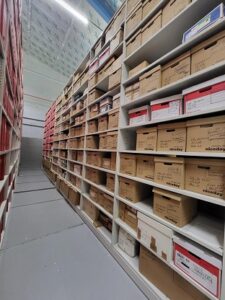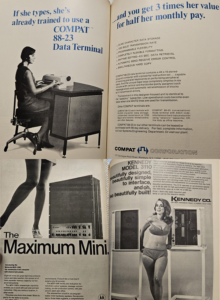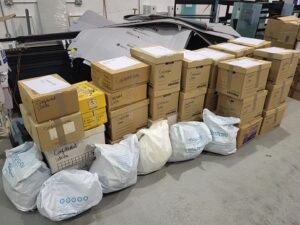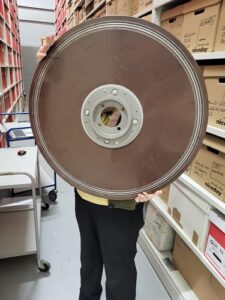By Abigail Hartley, Appraisal Archivist and Archives Collections Manager

ITI prior to processing, totalling over 70 linear metres of material
Several months ago, my colleague Jasmine Hide and I wrote two introductory posts about our new roles and what they entailed. This time, I would like to draw attention to a collection we recently appraised, that of the Information Technology Infrastructure, or, in its condensed form, ITI.
Now, it is no secret that – aside from our crucial Digital and Web Archivist team members – most archivists are not experts on the early history of computing. Having said that, for sixty years Edinburgh has prided itself on its forward-thinking approach to IT, particularly artificial intelligence. This is therefore an important collection that needed processing.
Arriving from the Department of Computer Science in 2017, the collection contains material that shows the development of the Edinburgh Regional Computing Centre, as well as the development and implementation of large-scale computing projects, services, applications, and programs from 1966 up to around 2000. It will be of particular interest to anyone researching the development of computing science, both as a practical feature in people’s lives, as well as the academic field.

Advertisements from early computing magazines often had interesting marketing tactics…
Edinburgh University, following on and concurrently working with the pioneering work of Cambridge and Manchester Universities, helped lead the way for computing to become a fixture in our lives. From DECtapes, computer print outs, correspondence, committee minutes, and installations of new equipment across campus, there’s a lot for a person to sink their teeth into.
One example may be the role of women in early computing. As computers were frequently seen as adjacent to secretarial work (itself seen as a ‘lesser’ career), computing magazines of 1960s frequently featured objectifying and sexist advertisements. Compare this to the work of women within places like the Edinburgh Regional Computing Centre, where the ITI collection shines. Women are both visually prominent, fully clothed, and their leading roles in the development of IT is well documented.

…But the reality does not always match these portrayals.
There was also a lot of material – to say in polite academic terms – surplus to research requirements.
To keep what is of value to the University, researchers, or anyone with an interest in ITI, we must think about its age, physical form, its function, what information and evidence it provides, its potential uses and how it sits within the University’s organisational structure.
Jasmine and I created an extensive list, giving a top-level overview of 215 boxes worth of content. Then, with these pre-established factors in mind, we were able to determine what material was worth retaining, transferring, or disposing. For some records, further consultation and context was required. This came in the form of conversations with Rachel Hosker, our University Archivist, and with ITI, for who knows the value of computing records better than the Department themselves?

Material awaiting confidential waste pickup and destruction. The volume has since grown!
This collaboration ensured accountability and a better understanding of the material in the broader context of the history of IT, the University, and the people who worked within.
Rehousing is another major concern. During the transfer to our University Collections Facility, outsized objects had been piled into large boxes. These boxes are so large and so heavy that even two people cannot comfortably handle them. To improve accessibility, these need to be split up and placed into smaller, easier to hold boxes.
When it comes to the physical format of the collection, the vast majority is paper based. However, there is physical media that will require a bit more investigating before further decisions can be made. DECtapes from the 1960s, for instance, will require specific tech to access and read (indeed, if the material has not yet degraded beyond use) to better determine its value. There are also objects which can only be described by the uninformed as giant unidentified frisbees. These, if nothing else, can be viewed as an example of this type of object, as opposed to its value being derived from the information it contains. As a quick side note: if you know what these could possibly be or what purpose they served, we could gladly receive ideas!

An example of one of the more unusual materials contained within the collection
The end goal of appraisal is always to increase accessibility. We do this intellectually, by creating a box list of contents, and physically, by consolidating and improving storage of the records themselves.
With 215 boxes to review, 36 have in their entirety been marked for disposal. Thereafter, the collection will require rehousing in new low acid boxes. What will be left is a collection prepped to be catalogued, reviewed by conservation colleagues and digital archivists, moved to more stable housing, and ready to be made accessible for teaching and research.
A simple task!
